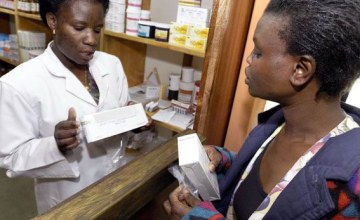via MedPage Today, by Ed Susman
 Pre-exposure prophylaxis with antiretroviral drugs failed to prevent women in Africa from becoming infected with human immunodeficiency virus (HIV) – apparently because more than half the women failed to take their medication.
Pre-exposure prophylaxis with antiretroviral drugs failed to prevent women in Africa from becoming infected with human immunodeficiency virus (HIV) – apparently because more than half the women failed to take their medication.
In a press briefing here at the Conference on Retroviruses and Opportunistic infections, Van Damme said it was likely that lack of adherence resulted in the failure to show a difference between those women on the active antiretrovirals and those who received placebo.
"The women in the study seriously overestimated adherence," she said. The participants told researchers that they took their assigned medicine 95% of the time. Pill counts indicated that 85% of the pills were not returned at regular points in the trial. But tests for emtricitabine/tenofovir in the blood of patients showed that only about 40% of the women had levels of the drug that would indicate the pills had been ingested within 48 hours of the tests.
The study was stopped early when an interim analysis showed that it was unlikely to prove positive.
The so-called FEM-PrEP was a randomized, double-blinded, placebo-controlled trial of once-daily oral emtricitabine/tenofovir. The primary effectiveness endpoint was incident HIV infection during 52 weeks of follow-up.
Participants attended screening, enrollment, and follow-up visits monthly. HIV seroconverters were taken off the product and followed for an additional 52 weeks
Read the Rest.
[Content that is linked from other sources is for informational purposes and should not construe a Mapping Pathways position.]
 Pre-exposure prophylaxis with antiretroviral drugs failed to prevent women in Africa from becoming infected with human immunodeficiency virus (HIV) – apparently because more than half the women failed to take their medication.
Pre-exposure prophylaxis with antiretroviral drugs failed to prevent women in Africa from becoming infected with human immunodeficiency virus (HIV) – apparently because more than half the women failed to take their medication.The incidence of HIV infection among previously uninfected women treated with a co-formulation of emtricitabine and tenofovir (Truvada) was 4.7 per 1,000 person-years compared with a rate of 5 per 1,000 patient-years among women in the placebo group (P=0.81), said Lut Van Damme, MD, PhD, senior scientist at FHI 360, in Durham, N.C.
In a press briefing here at the Conference on Retroviruses and Opportunistic infections, Van Damme said it was likely that lack of adherence resulted in the failure to show a difference between those women on the active antiretrovirals and those who received placebo.
"The women in the study seriously overestimated adherence," she said. The participants told researchers that they took their assigned medicine 95% of the time. Pill counts indicated that 85% of the pills were not returned at regular points in the trial. But tests for emtricitabine/tenofovir in the blood of patients showed that only about 40% of the women had levels of the drug that would indicate the pills had been ingested within 48 hours of the tests.
The study was stopped early when an interim analysis showed that it was unlikely to prove positive.
The so-called FEM-PrEP was a randomized, double-blinded, placebo-controlled trial of once-daily oral emtricitabine/tenofovir. The primary effectiveness endpoint was incident HIV infection during 52 weeks of follow-up.
Participants attended screening, enrollment, and follow-up visits monthly. HIV seroconverters were taken off the product and followed for an additional 52 weeks
Read the Rest.
[Content that is linked from other sources is for informational purposes and should not construe a Mapping Pathways position.]

No comments:
Post a Comment